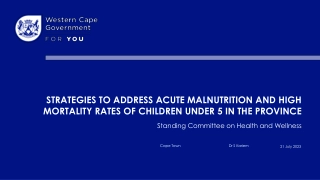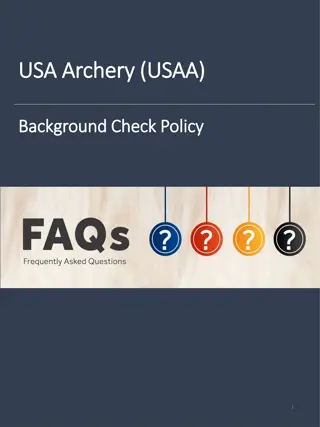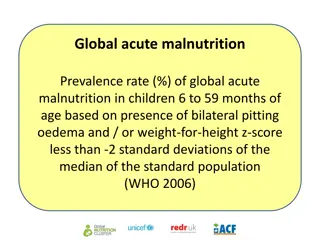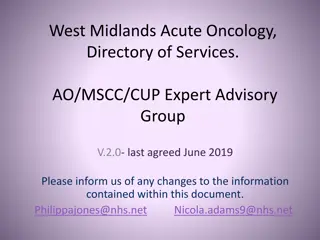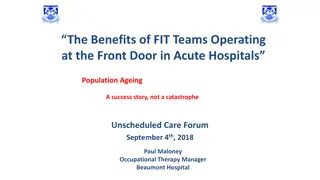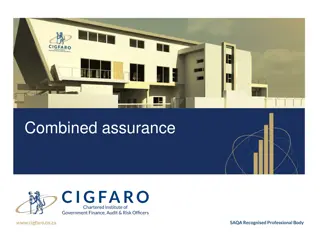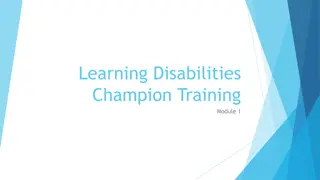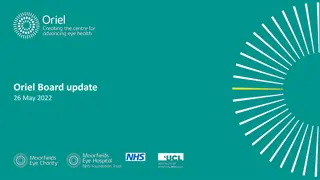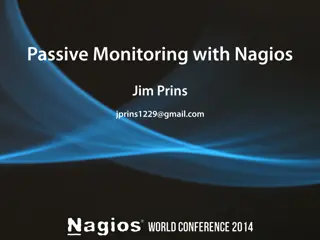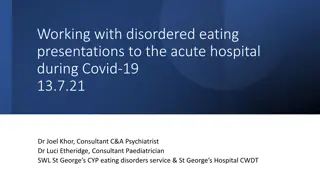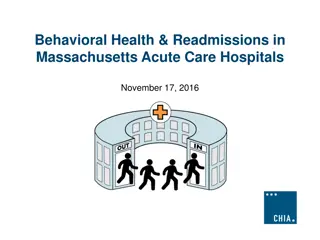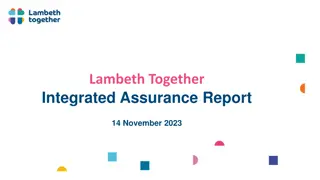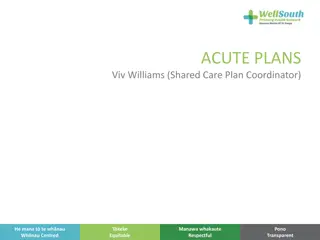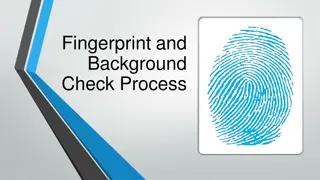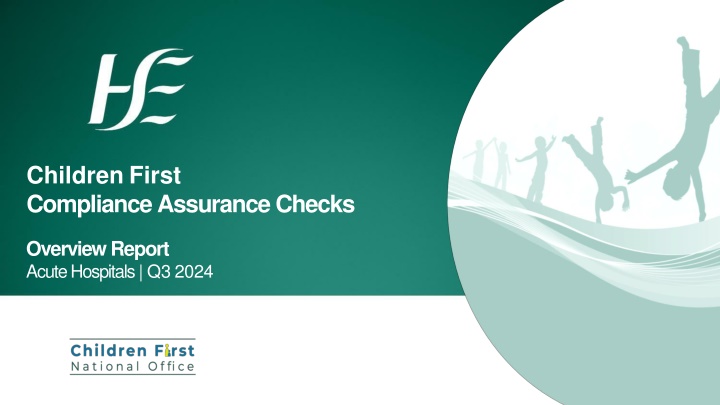
Compliance Assurance Checks at Acute Hospitals: Overview Report Q32024
Discover the outcomes of Compliance Assurance Checks conducted at Acute Hospitals by the HSE Children First National Office between June and October 2024. Findings show areas of compliance, challenges faced, and reasons for non-compliance. Efforts to meet Children First requirements are evident, but improvements are needed in risk assessments and record-keeping.
Download Presentation

Please find below an Image/Link to download the presentation.
The content on the website is provided AS IS for your information and personal use only. It may not be sold, licensed, or shared on other websites without obtaining consent from the author. If you encounter any issues during the download, it is possible that the publisher has removed the file from their server.
You are allowed to download the files provided on this website for personal or commercial use, subject to the condition that they are used lawfully. All files are the property of their respective owners.
The content on the website is provided AS IS for your information and personal use only. It may not be sold, licensed, or shared on other websites without obtaining consent from the author.
E N D
Presentation Transcript
Children First Compliance Assurance Checks Overview Report Acute Hospitals | Q32024
Hospitals selected for Compliance Check The HSE Children First National Office undertook Compliance Assurance Checks with eight randomly selected Acute Hospitals between June and October 2024. Four of the hospitals selected were HSE hospitals and four were HSE Funded hospitals. Hospital Managers were invited to attend an Information Session and all were provided with a copy of the HSE Children First Compliance Assurance Framework from the outset. Each hospital received a report following the Check.
Overview of Findings Areas of Compliance CSS in accordance with legislative requirements Sufficient Risk Assessment undertaken CSS in accordance with Tusla guidelines Funded services - CPW Policy Consistent CSS CSS CPW Policy read by all staff CPW Record Management Procedure CPW Reporting Procedures Self-audit checklist completed CSS reviewed within 24mths eLearning Completed Displayed appropriately furnished to all staff 3 4 4 8 8 6 5 2 6 5 8 6 5 4 4 0 0 1 2 1 2 3 0 0 0 0 0 0 0 1 1 1 0 0 0 2 38% 50% 50% 100% 100% 75% 63% 50%* 75% 63% 100% 75% Evidence full compliance Evidence full compliance Evidence full compliance Evidence full compliance Evidence full compliance Evidence full compliance Evidence full compliance Evidence full compliance Evidence full compliance Evidence full compliance Evidence full compliance Evidence full compliance *Four HSE hospitals and four HSE Funded Hospitals participated in these Checks. Evidence of compliance Evidence of partial compliance No evidence of compliance
Summary Findings (continued) Good evidence of compliance was noted across the acute hospitals selected. It was evident that efforts had been made by all services to implement Children First requirements. Challenges however still remain, particularly in relation to risk assessments and record keeping. Of the requirements checked there were 65 findings of full compliance, 22 findings of partial compliance and 5 findings of 'non-compliance'. Reasons for findings of 'no' or 'partial' evidence of compliance: 1. Additional risks should have been considered in Child Safeguarding Risk Assessments e.g. risks in relation to the use/misuse of digital images, clinical research, volunteers, visiting and outings. 2. Controls were identified in some Risk Assessments but were not in place e.g. child protection and welfare policy, visitors policy, clinical photography, intimate care policy. 3. Prescribed procedures (i.e. for appointing a Relevant Person and for maintaining a list of Mandated Persons) were not available. Not all hospitals could evidence that all staff had completed mandatory Children First training or had read the Child Protection and Welfare Policy. Procedures were not always in place to ensure that Child Protection and Welfare records are stored appropriately and record retention periods were not always in line with HSE Policy. 4. 3.
Summary of Findings (continued) Good practice: It was evident that some hospitals had gone to additional lengths to prominently display their Child Safeguarding Statements. One hospital displayed their CSS alongside an eye-catching poster with colourful figures asking that children be supervised at all times. Suggestions made to hospitals: To consider including the CSS on their hospital website. To develop procedures for the appropriate taking of photographs of patients when clinical photography is not available or necessary. To ensure that record management procedures address the requirement for CP&W records to be available on a need to know basis i.e. their existence and whereabouts should be noted on the main chart and if archived, the notes should be retrievable.
Risk Assessment | Assessment of any potential for harm to a child Overall Findings Children First Act 2015 3 Compliant Requirement 5 Partial Compliance An assessment of any potential for harm to a child must be undertaken (risk assessment). 0 No Evidence of Compliance 38% Compliance Rate Key Findings: It was determined that additional risks should have been considered in some of the risk assessments as gaps based on the nature of the services provided were identified. Procedures were listed or identified as being in place in relation to some, but not all, of the risks identified and in some cases not all procedures were in place. In one hospital, some controls that were in place in one hospital were not mentioned in the risk assessment.
Child Safeguarding Statement | Legislative Requirements Children First Act 2015 Overall Findings 4 Compliant Requirement 4 Partial Compliance A Child Safeguarding Statement (CSS) must be prepared in accordance with legislative requirements*. 0 No Evidence of Compliance Key Findings: 50% Compliance Rate Procedures were not in place to mitigate all of the risks identified e.g. risk of harm in relation to visitors, 16-18 year olds attending unaccompanied, the provision of intimate care and the use/misuse of digital imagery (clinical or otherwise). Not all hospitals could evidence that they had the prescribed procedures listed in Section 11(3) of the Children First Act 2015 in place i.e. a procedure for appointing a Relevant Person and a procedure for maintaining a list of mandated persons. *(i) The CSS must describe the service being provided and the principles to be observed to safeguard children while availing of the service (ii) A Relevant Person must be appointed for the purpose of the CSS (iii) The CSS must include a written assessment of any potential for harm to a child while availing of the service (iv) The CSS must specify the procedures that are in place to manage any risk identified and the prescribed procedures required to be in place, as listed in Section 11(3) of the Children First Act 2015.
Child Safeguarding Statement | Guidance issued by Tusla Children First Act 2015 Overall Findings 4 Compliant Requirement 4 Partial Compliance A Child Safeguarding Statement must be developed with due regard to, and in accordance with, any guidelines issued by Tusla Child and Family Agency*. 0 No Evidence of Compliance Key Findings: 50% Compliance Rate It was determined that additional risks should have been considered in the risk assessment based on the nature of the service provided. Some of the risks that Tusla would expect Relevant Services to have considered were not addressed in the risk assessment i.e. use/misuse of digital imagery. In hospitals where clinical photography is not available, photographs are often taken by clinicians using mobile phones or tablets. This risk of these images being used inappropriately is therefore relevant and should have been considered. Contact details for the Relevant Person were not provided and no reference was made to a secondary risk assessment. *Guidelines referenced in this section of report are taken from Tusla's Checklist Review Outcome Form Ref: RF/CSSCU/005
Child Safeguarding Statement | Display Children First Act 2015 Overall Findings 8 Compliant Requirement 0 Partial Compliance A Child Safeguarding Statement must be displayed in a prominent place where the relevant service concerned relates or is provided or both, as may be appropriate. 0 No Evidence of Compliance 100% Compliance Rate Key Findings: Child Safeguarding Statements were displayed prominently in all hospitals as per the legislative requirement.
Child Safeguarding Statement | Furnished and made available Children First Act 2015 Overall Findings 8 Compliant Requirement 0 Partial Compliance A provider of a relevant service shall furnish a copy of the Child Safeguarding Statement to members of staff and, on request, to parents, guardians, members of the public and Tusla Child and Family Agency. 0 No Evidence of Compliance 100% Compliance Rate Key Findings: All staff were furnished with a copy of the service's Child Safeguarding Statement and copies were made available to parents, guardians, members of the public and Tusla on request.
Child Safeguarding Statement | Review Children First Act 2015 Overall Findings 6 Compliant Requirement 1 Partial Compliance A provider of a relevant service shall review a Child Safeguarding Statement at intervals of not more than 24 months or as soon as practicable after there has been a material change in any matter to which the statement refers. 1 No Evidence of Compliance 75% Compliance Rate Key Findings: In one hospital the previous Child Safeguarding Statement was not dated. While it was evident that this Statement had been reviewed, the hospital could not evidence that it was reviewed within the legislative timeframe. In a second hospital, the previous CSS had not been reviewed within a 24 month period.
Child Protection & Welfare Policy | Appendix 3 or equivalent Children First Act 2015 Overall Findings 5 Compliant Requirement 2 Partial Compliance All staff must ensure that they have read and understand their responsibilities as set out in the Service's Child Protection and Welfare Policy. 1 No Evidence of Compliance 63% Compliance Rate Key Findings*: There was no Child Protection and Welfare Policy in place in one hospital. Not all hospitals could evidence that all staff had read the Child Protection and Welfare (CPW) Policy. In some hospitals a targeted approach was being taken i.e. staff working in Paediatric and Emergency Departments had read it, however the requirement is that all staff should read the CPW Policy. * Please note that findings for this requirement are based on signed declarations by the Service Managers only.
Child Protection & Welfare Policy | Funded & Contracted Children First Act 2015 Overall Findings 2 Compliant Requirement 1 Partial Compliance HSE funded and contracted services should have a CPW Policy that is consistent with the core components of the HSE CPW Policy. 1 No Evidence of Compliance 4 N/A Key Findings: 50% Compliance Rate* One hospital did not have any CPW Policy in place. In one hospital, procedures in relation to record keeping were not consistent with the HSE Child Protection and Welfare Policy. * Four of the seven hospitals selected were HSE Funded Services.
Mandatory Training | 'An Introduction to Children First' - 3 yearly Children First Act 2015 Overall Findings 6 Compliant Requirement 2 Partial Compliance All HSE staff, volunteers, students, contracted staff and staff of HSE funded organisations are required to complete the mandatory HSE eLearning module An Introduction to Children First , as required (currently every 3 years). 0 No Evidence of Compliance 75% Compliance Rate Key Findings*: It could not be determined from the information provided by one hospital whether all staff had completed mandatory Children First training. One hospital reported that this training was not up to date for all staff. * Please note that findings for this requirement are based on signed declarations by the Service Managers only.
Child Protection & Welfare Records | Record Management Children First Act 2015 Overall Findings 5 Compliant Requirement 3 Partial Compliance Child protection and welfare records must be appropriately filed and securely stored in a manner which upholds the confidential nature of the information. 0 No Evidence of Compliance 63% Compliance Rate Key Findings: It was unclear as to whether or not record management procedures were being consistently implemented across all hospital departments. Records were not always accessible to staff on a 'need to know' basis, for example: records stored in confidential Social Work notes that are not accessible to staff out of hours. records sent for archiving with no reference retained on site to child protection and welfare concerns. no reference on a patient's chart to indicate that a separate child protection record exists and details on how staff can access these records.
CP&W Concerns | Reporting Procedure Children First Act 2015 Overall Findings 8 Compliant Requirement 0 Partial Compliance All organisations should have procedures in place for reporting child protection and welfare concerns. Procedures should be made available and followed by all staff members, students and volunteers. 0 No Evidence of Compliance 100% Compliance Rate Key Findings: CPW Reporting Procedures were in place in all hospitals.
Service Arrangements| Funded & Contracted* Children First Act 2015 Overall Findings 6 Compliant Requirement 0 Partial Compliance The Implementation and Compliance Self-Audit Checklist for HSE and HSE Funded and Contracted Services must be completed annually and made available to the HSE on request. 2 No Evidence of Compliance 75% Compliance Rate Key Findings: Two hospitals (one HSE and one HSE Funded) could not evidence that Self-assessment Checklists were being completed annually.
Please direct queries to: HSE Children First National Office childrenfirst@hse.ie www.hse.ie/childrenfirst

